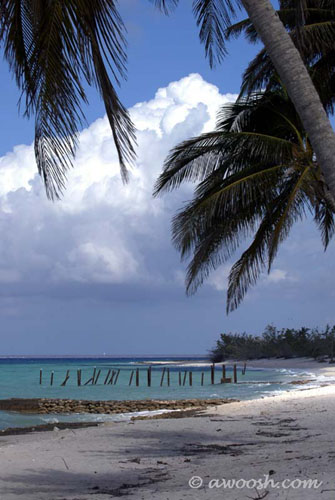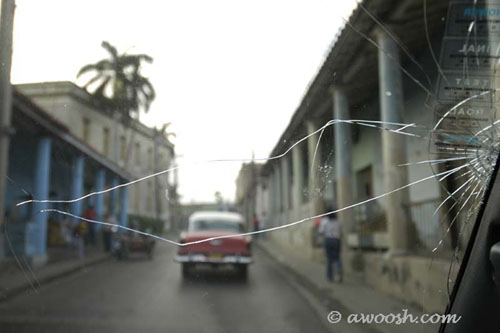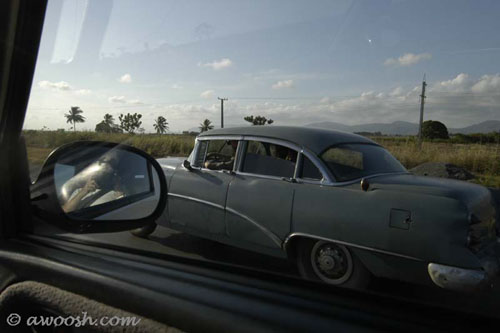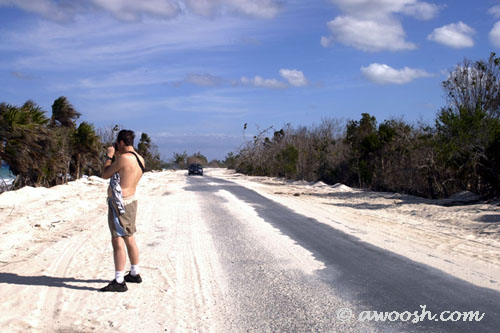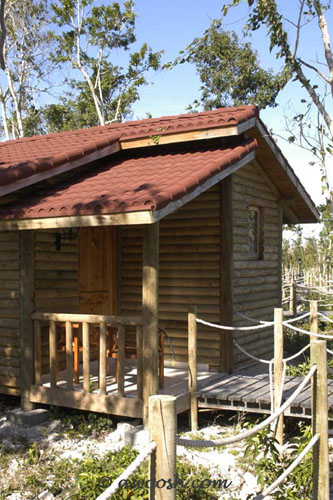Cuba's Maria La Gorda: The Fat Lady Sings An
unspoiled diving paradise in the Caribbean? My intentions for the following photo essay are twofold: firstly to share the experience with folks who may not have the opportunity to visit Cuba any time soon, and secondly, because I could find very little practical information about Maria La Gorda before our trip there, to provide details about the resort and diving as a service to other divers who might make the pilgrimage. As Canadians, we are permitted to travel to and around Cuba. I do not in any way recommend that American readers of this photoessay go against the wishes of their government and travel in Cuba. Much as I think Cuba is a wonderful place, I do not think that going to Cuba is worth the logistics, legalities, potential huge financial penalties and personal risk to which Americans expose themselves if they visit the country. Readers not interested in minutae about the journey and/or the resort and who just want to find out about the diving can skip ahead to the diving photo essay and/or to the multimedia slideshow and photo galleries - topside and underwater. Larger images of all thumbnails in this photo essay may be viewed in the photo galleries linked just above and again at the end of the article. There is also a low-tech slideshow option in the galleries for Mac viewers who can not download the exe multimedia show.
A Bit of History I sampled my first taste of Cuban diving in December 2003. In search of a budget-friendly Christmas beach holiday that included some diving for the three divers in our family, we traveled to the Northeast coast (Playa Pesquero), near Holguin. Although the reef was in pretty good shape, the diving was uninspired, mostly due to the worrisome lack of fish and pelagics, and the beach was congested with sunseeking winter tourists who had for the most part been herded in on package deals from Canada and Britain. On the same trip, we made a day trip to Havana. The city is interesting and charming and was well worth the effort and cost to visit. After that trip I also wrote about my impressions of Cuba and traveling in a country very politically different from my home and native land. Intrepid friends flew to Varadero in March 2004, rented a car and explored the western provinces of Cuba. On their return they reported that Maria La Gorda was a charming outpost with a beautiful beach, and more importantly, they reported that the divers that they had met at the resort during their brief stay had raved about the diving. They themselves are not divers, but had found the snorkeling to be very good. With this inside information, we decided to return to Cuba in search of the holy diving grail - that is an off-the-beaten-tourist track, budget-minded location that offered great diving. A Canadian company (cubafriends.ca) that specializes in non-profit Cuba travel for students and humanitarians helped us with our all of our arrangements and bookings, and did an excellent job. I would highly recommend the services of Marcel who was very patient and thorough as we sorted through the logistics of getting to and from the resort, defining the dive program, and making sure that we were able to secure the accomodations we wanted. As far as I know, there is no way to communicate directly with the resort at Maria La Gorda, and all bookings are made through La Gaviota, which is an omniscient Cuban tourism entity that operates hotels, buses, dive ops and aircraft.
It's All in the Name The story goes that Maria La Gorda was an aboriginal Venezuelan woman who was abducted by pirates and left marooned on the far reaches of the island of Cuba when they had had enough of her. The party line is that, to make the best of her situation, she ran an inn to accommodate travelers, but reading between the lines, it is more likely that she was forced by her circumstances into prostitution. Whatever her lot in life may have been, she was apparently a very large and memorable lady, hence the naming of Maria La Gorda (Mary the Fat). Even with this sordid history, Maria La Gorda shines as one of those places that is still so difficult to get to that only divers in the know and backpackers clutching their Lonely Planet Cuba guidebooks make the effort to travel there. There is no bus service to Maria La Gorda and the nearest (non-international) airport (Viñales) is several hours’ drive away. Through the resort’s Cuban booking agents, visitors can arrange transfers to and from Havana or Viñales, or judging by the population of rental vehicles parked at the resort, many visitors brave the challenging driving conditions and drive themselves in.
Money Matters We had been advised to change our Canadian dollars to Cuban Convertible Pesos (CCP), the official tourist currency in Cuba, before leaving the airport in Havana. There are a couple of Cadecas (currency exchange booths) in the luggage collection area at the airport, but you can expect huge lineups there. A tip: gather your bags and go up one floor to the Departures level where there are several Cadecas that are not busy at all. Money converted to CCP in Cuba can be exchanged for your country's currency on exit. Convertible Pesos are not exchangeable outside the country of Cuba. Last year, American currency was accepted everywhere we traveled in Cuba (and in fact was the currency of choice to pay the $25 pp exit fee at the airport), but in the span of a year, things have changed. US currency is no longer accepted by businesses (altho apparently still very welcome as tips) and in fact a premium of 10% is being charged to convert US dollars to CCP at banks and Cadecas. The CCP and the US dollar share the same value. Also, US bank (ie American Express) traveler's cheques are not accepted in Cuba in trade or at the cash exchange, even when in Canadian denominations. Ditto credit cards. Cards issued by US banks will not be accepted in Cuba. My undertanding is this is because of legal issues in the US regarding financial institutions honouring transactions made in Cuba. With all that confusion about money, we decided it was simplest to bring Canadian cash and convert it at the airport - we didn't need a lot of money, just enough to cover our bar bill, any excursions we might undertake, emergency funds and tips. It is one of the big advantages of paying the package up front, and buying meals included. It is important to note that Maria La Gorda does not accept credit cards and it is at least a one hour's drive to the nearest money exchange. Plan accordingly.
The Road Less Traveled In search of diver’s paradise, we undertook the harrowing five hour drive from the International Airport in Havana. Rather than renting a car that would likely sit idle whilst we spent ten days diving and beachcombing at Maria La Gorda, not to mention having to navigate the poorly signed and labyrinthine roads that lead to and from the resort, Marcel at Cubafriends arranged to have a driver meet us at the airport in Havana and transport us and our embarrassingly numerous bags in a van. Luis, a Cuban representative of the travel company, met us at the Arrivals, handed over our vouchers for rooms, meals & diving packages for the resort, and then quickly dispatched us into the van, driven by a very kind older Cuban gent by the name of Guevera (as in Che). Guevera (and I have no idea if this is his first or last name) was an excellent, professional driver, who spoke not one word of English. My Spanish is pretty rusty these days (and at the best of times was never very good), but being the only person in our family who has even a sniff of the language, I sat up front beside him in the van, camera at the ready to attempt to shoot the gorgeous verdant countryside while hurtling down the highway at 120 km/hour, and tried to make polite conversation. I shudder to think of the numerous errors that I made, but somehow we did manage to communicate on the basics – what time we would arrive at the resort, whether there would be some food there for us on arrival, asking him to stop for a baño (bathroom) break and to buy some agua (water), asking him about the numerous crops we saw growing on the roadside (plantains, sugar cane and acres and acres of tobacco apparently), and every now and then (me) cringing and uttering “Oy perro” (dog) in anticipation of him flattening one of the many scrawny Cuban mutts (think of Bart Simpson’s dog Santa’s Little Helper and you’ve got the picture) playing russian roulette on the road in front of the van. But Cuban dogs are Darwinian beasts – those that figure out that the big boxes on wheels arriving at superspeeds can hurt them somehow survive, seeming to know instinctively when to get of the way just in the nick of time.
Highway driving in Cuba is almost surreal. A divided, modern two lane autopista (highway) runs from Havana to the city of Pinar del Rio, capital of the western province, also named Pinar del Rio. This part of Cuba is a very important tobacco growing center. The highway was an amazingly ambitious undertaking, with a median that is planted with groomed bougainvilleas, hibiscus and other flowering tropical bushes for a hundred miles or so. The huge highway is sparsely populated by private chartered vans like ours, occasional behemoth tour buses, rental cars, and government-issue Eastern Bloc coupes. And then there are the ancient, blue smoke spewing, in death’s final throes, circa 1950’s commuter buses and open bed farm trucks that double as collectivos for the Cubans who stand ever-patiently (or perhaps resignedly) on the roadside waiting for a ride. Some folks attempt to bribe potential rides by waving a braid of garlic or a peso bill at the vehicles bearing down on them. All government owned vehicles (which make up the majority of the traffic on the road) are required to stop and give rides if they have space, and there are uniform clad men standing at the major collection spots (usually near overpasses where other roads intersect with the highway) to make sure that drivers comply. There are also a disproportionate number of radar traps set up along a road that is so little traveled. The colourful parade of the few vehicles that the Cubans are allowed to own and and operate covertly signal each other about the traps ahead by flashing their lights at oncoming traffic. These cars are the picturesque 1950’s M&M coloured Cadillacs, Buicks, Chevys, etc, that limp along at top speed, which for these out of tune antiques is somewhere around 50 km an hour. Windows rolled down, driver’s elbow protruding out the window, and numerous bodies crammed into the back seat – it’s a Cuban postcard.
And finally, along the side of the road, sometimes actually on the road, are horse and oxen drawn carts and bicycles, often with several riders aboard. It is really quite a trip. Once arriving at Pinar del Rio (the city) the autopista abruptly ends, and the second half of the journey is made along winding, patched roads through the beautiful countryside, punctuated by occasional small towns and villages. The van’s horn becomes Guevera’s friend and he uses it often as he speedily passes every vehicle he encounters on our side of the road. Near misses with ox and horse carts, bicycles, pedestrians and dogs keep his horn well exercised and keep us passengers white-knuckled for the duration. As the sun tumbles behind the Cuban mountains, we continue flying through the countryside. The nearer we get to the destination, the more we see of structures missing chunks of roof. Hurricano? I ask Guevera, gesturing towards the damage. Si, he replies.
Ivan the Terrible Was Here Ivan had been very much in our thoughts in the months leading up to this trip. We knew that Maria La Gorda and the west end of the island had been hit very hard by the Category 5 hurricane, and despite assurances from Marcel, the Cuba travel specialist, we had our concerns. Sure, they got the resort at Maria La Gorda up and running again within weeks of the storm, but information/propaganda coming out of Cuba was difficult to garner, and having seen the images of the incredible devastation on Grand Cayman, also in the path of the monstrous storm, we worried that the resort, beach and the reefs would be in very rough shape. However, rather than relocate our destination to another part of Cuba that had been less impacted by Ivan, we decided that if the resort was open, we would support the local economy by staying there.
My worries were not assuaged by the final 20 km drive into Maria La Gorda. There was a lot of damage here – as evidenced by the number of tree trunks that had been bucked up and were neatly piled all along the shoulders of the road. Tons of branches and piles of leafy detritus also lined the road’s edge, and as we headed down the final hill that took us to the last 10 km drive in along the beach, my heart sank. It was going to be a white Christmas after all. The sand piled up on both sides of the road, in the headlights of the van, looked like a snowplow and been along and cleared the way after a blizzard. Even in the dark of night, it was easy to see that there was a lot of dead vegetation too – the sea had apparently breached the road and washed up into the marshes on the other side, and the salt was killing the plants. Parts of the road had been washed away and in some areas we were driving over corduroy sand and chunks of dead coral before finding the road again. By this point, I was really concerned – would the beautiful palm-tree lined beach of the photographs I had seen of the resort be gone? Would the reefs be destroyed? Finally, the road trickled down into a driveway blocked by an armed gate into the resort. We had arrived. Several of the resort’s guests (in retrospect probably most of them as there was no where else to congregate after dinner) eyed us from the rustic outdoor bar as we climbed down from the van and shuffled sleepily into the reception to check in. Passports were scrutinized and salient details were recorded, vouchers relinquished, keys were handed over, and then we were wheeling our bags over a wooden walkway suspended above the mangrove that led to the little wooden cottages that would be our home for the next 10 days. We were most relieved to wake up the next morning and see palm trees on the beach, swaying in the breeze. If you looked around, there was some evidence of hurricane damage, but nothing as drastic as we had feared. As for the condition of the reefs - you'll have to read ahead to the diving section of this photoessay to get the goods.
Maria La Gorda Resort
The resort at Maria La Gorda offers three kinds of accommodations: a couple of the original beach cabins that line the waterfront (which were surprisingly still intact after the big blow), three pink multi-unit rather utilitarian looking buildings, some rooms of which overlook the Caribbean, and a good supply of quite new small log cabins that apparently were prefabricated in South America and brought in to Maria La Gorda. The log cabins are set back on pilings over the marsh with a distant view of the water. I loved the privacy of these little cabins, and by Cuban standards, they were very nice, though basic in decor – private bathroom, tv (which we never turned on, more on that later), air conditioning and ceiling fan, and a private veranda with some handsome but very uncomfortable wooden chairs for surveying the lovely sunsets. There are several power outlets in the cabins, running on 220V with eastern European two prong receptacles.
And there was that charming wooden walkway from the main driveway back to the cabins that was lined with a greeting committee of cats. That’s right, cats. Nary a dog in sight (they’re all busy playing chicken with the traffic on the road). Maria La Gorda (they should really rename it Maria Los Gatos) is infested with feral cats, and these dudes have figured out how to con soft-hearted guests like us into bringing back tidbits from the dining room for them. Our kids named all their favorites and kept them well-nourished during our time there. Tears were even shed on good-byes by P3, who desperately wanted to bring one home.
Chow Time There are two restaurants, also haunted by cats, at Maria La Gorda. The cats actually seemed to have their territories – there were buffet dining room cats, bar & main restaurant cats and cabin cats and never the three should meet. Lording over it all was what the kids named “The Devil Cat”, a big, fat black cat (an anomaly in a sea of very skanky malnourished cats) who seemed to roam the place at will, and almost preternaturally materialized from out of the gloom, snarling and scaring the other cats away, whenever food was being doled out. By the end of the week, we figured there had to be at least 20 to 30 regular cats hanging about.
We bought a meals-included package (the way to go in my opinion when traveling with a herd of hungry teens), and so only ate in the buffet-style restaurant near the dive shack. There was a second, small, a la carte restaurant adjacent to the bar, and the food looked pretty good from a distance, but it was not cheap. The buffet meals, if you buy them at the resort are $15 each for lunch and dinner (Cuban Convertible Pesos – one peso is equivalent to one US dollar), which is quite steep when you consider the cost of living in Cuba. The food was plentiful and well-prepared, but typically Cuban in that it was bland. These people have apparently not heard of jalapeños. We ate a steady (meaning not very varied) diet of chicken (cooked in several ways), rice, surprisingly good beef and pork, tomatoes (prepared several ways), sweet peppers (ditto), cucumbers (tritto), what I think was jicama, and tons of oranges, grapefruit, papaya and pineapple that, like the veggies, were attractively sliced and diced and laid out on platters. Every now and then they would throw a curve by producing some bananas or apples or grapes or shredded lettuce. For the special festive meals (Christmas Eve and New Year’s Eve) they went all out and had a butterflied turkey with a funky stuffing and a whole roasted pig, amongst other delicacies. Dessert was sketchy – usually some rock hard pucks loosely resembling cookies, squares of dry cake and a kind of runny baked custard that did not appeal to us. Oh yeah, and a bizarre special cake with smurf blue icing for Christmas and New Year's. Ice cream was sold a la carte, as was bottled water (not cheap – $2 for 1.5 litres) and beer (almost cheaper than water at $1.50 a bottle). Breakfast was a bit of a non-event – they’d cook up some eggs to order in an omelette (with cheese and ham if requested), scrambled or fried, there was some mystery meat to go with in the steam table as well as some greasy looking crepes trying (unsuccessfully) to pass themselves off as pancakes, canned juice (mango or pineapple), the ubiquitous fresh sliced & diced oranges, grapefruit and mango, and some dried husks that were more like crackers than bread. There were also some sliced meats and cheese, as the clientele of Maria La Gorda is almost exclusively European, and they like to eat that kind of stuff in the morning. I tell you, at the end of our stay, I would have given my kingdom for a slice of hot toast, butter and jam. It was a banner day if there was hot milk in the morning with which to concoct a café con leche, otherwise it was black coffee or tea at all meals. All in all, I would say the quality of the food was very good, if not very varied. We all came home feeling exceedingly healthy for lack of junk food and sugar intake which we replaced with copious amounts of fresh fruit and veg.
Bars & Cigars There is only one bar in the resort. It is covered but is open to the elements, including swooping bats, bloodthirsty noseeums and the aforementioned flea-infested bar cats lounging under the plastic tables and chairs. There was some live entertainment (a Cuban trio) playing most nights we were there, and they pipe in music otherwise. In a nod to western civilization, there is a tv screen mounted above the bar where movies in Spanish play constantly, mostly to entertain the rather laconic bar staff it seems. Think Cuba and drinks and the word "Mojito" should come immediately to mind. It is a refreshing concoction: crushed fresh mint, sugar, simple syrup and white Cuban rum, topped off with soda water. A rum and coke is a good thing too, but don't be calling it a Cuba Libre ;^) Highballs are $2 at Maria La Gorda. Available soft drinks were Cuban knockoffs of Coke, Sprite & Fanta and cost $1 per can. Cuban beer is fantastic stuff - for a lighter beer, Cristal is the thing to order. But for a "real" beer, the wonderful, malty Bucanero is the ticket. Beer costs $1.50 at the resort. Wine is available by the bottle, but as we didn't sample any, I don't know quality or costs. A large bottle of water (1.5L) is $2 at the bar and in the dining room (chilled) or $1.80 at the small convenience store located adjacent to the bar (not chilled). There are small bar fridges in the log cabins; I am not sure whether or not the other types of accommodations offer them as well. The modest convenience store also carries a limited selection of bathing suits, t-shirts, cigarettes, rum, snacks, pop, basic toiletries and some non-prescription medications (but not antihistamines). They also offer a fine selection of cigars. A box of mighty fine Cohibe cigarillos will set you back about $12. They stock most of the premium Cuban cigar brands, and the prices were comparable to the Duty Free in Havana Airport. It is an hour's drive to the nearest small town, so it is wise to bring a full first aid and travel medicine kit with you, as well as an adequate supply of sunscreen, toiletries, bug spray and afterbite cream.
Doctor in the House There is a doctor on site at Maria La Gorda, mostly, I suspect, to deal with any DCS issues that may arise in such a remote location. Air evacuation by helicopter to Havana is required for bent folks, so make sure your DAN insurance is up to date if you decide to dive Maria La Gorda. I don't know how many people require chamber treatments annually in this location, but with the combination of very steep and deep terrain, the number of inexperienced divers in the water, and some questionable diving practices (more on that later) I would wager a guess that they would not be unheard of. It was a good thing for us that there was a doctor in the house. P2 had a very adverse reaction to the sand fleas that infested the beach early in the morning and late in the afternoon. By Day 3 she was covered with ugly red welts, and she was unbearably itchy and otherwise felt miserable. She very quickly went through the supply of antihistamine pills in our med kit, and the kind doctor was able to supply her with enough pills to survive our ten days there, for a mere $5. $5 was ironically also the same cost as the ammonia afterbite solution sold at the store, no doctor's consultation included. Go figure.
The Beach, Amenities & Activities
Beautiful. Desolate. Palm tree lined. Shell strewn. Turquoise. You can walk for miles and never see another soul. That pretty much covers the description of the beach. The only negatives are the sand fleas (staying off the beach early in the day and late in the afternoon is recommended) and the amount of urchin-infested ironshore that makes for limited entry & exit points for snorkeling and swimming. Also, do not expect a groomed, raked, pristine stretch of sand in front of the resort. There is very little in the way of landscaping at Maria La Gorda (all in all I would describe it as a low maintenance place for low maintenance people). There is no troop of groundskeepers out at the crack of dawn lining up the plastic chaise lounges (of which there are some, although several are usuable due to broken bits) and picking up fallen coconuts and wind-swept dead fronds left over from the hurricane, nor the cigarette butts of inconsiderate smokers who insist on using the beach as one big ashtray. There are no beach waiters bringing out Pina Coladas to sunworshipping guests. There are also no beach vendors, palapas, jetskis, sailboats, parasailers, windsurfers, or drink til ya drop catamaran sunset cruises. It's a very quiet, serene sort of place where you sit under a palm tree to get out of the sun. There is also no internet, cell phone or Blackberry service, nor CNN, daily newspapers etc. In fact, it is so far from civilization that we did not know about the terrible tsunamis in southeast Asia until we got on the plane to come home a week after the horrific events. We were told that faxes can be sent and received at the resort for usurious prices. Ditto long distance telephone calls which can be made at the Reception. Kids brought to the resort need to be self-entertaining because there is no pool, no kids camp, no beach volleyball, no basketball hoop, no tennis court, no nuthin' other than acres and acres of gorgeous sandy beach and a beautiful sea in which to swim and snorkel. For me, that is a big part of what makes the place so charming, but buyer beware. Guests at Maria La Gorda can arrange a tour of the Biosphere Reserve located just north of Maria La Gorda that is apparently extremely rich in bird species, plants and marine creatures. It costs $10 per person for a guided tour (transportation extra, and all visitors must be guided). We did not partake of this opportunity, but our intrepid friends who put us onto Maria La Gorda did, and enjoyed it very much. There is a car rental desk at the resort adjacent to the reception, so visitors like ourselves who were transported to Maria La Gorda can rent a vehicle and explore the area. Snorkeling and diving excursions are offered daily through the dive shop. Which brings us to Part 2 - Diving at Maria La Gorda
|
